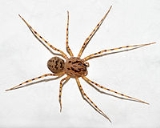
Spitting spider
Encyclopedia
Spitting spiders are members of the family Scytodidae. There are several genera
, of which Scytodes is the best-known. Over 150 species
of scytodids have been described worldwide.
Scytodidae catch their prey by spitting a fluid that congeals on contact into a venomous and sticky mass. Remarkably, though it is produced in venom glands in the chelicerae, the fluid contains both venom and spider silk in liquid form. The venom-impregnated silk not only immobilizes prey such as Silverfish
by tying it down, but has a venomous effect as well. In high-speed moving pictures, the spiders can be observed swaying from side to side as they "spit", catching the prey in a crisscrossed "Z" pattern; it is criss-crossed because each of the chelicerae
emits half of the pattern. The spider usually strikes from a distance of 10-20mm and the whole attack sequence is over in a little under 1/700th of a second. After making the capture, the spider will typically bite the prey with venomous effect, and wrap it in the normal spider fashion with silk from the spinnerets.
Like the Sicariidae
and Diguetidae these spiders are haplogyne (lack hardened female genitalia) and have six eyes, which are arranged as three pairs. The Scytodidae differ from the Sicariidae and Diguetidae in having a dome-shaped carapace and in their characteristic flecked pattern of spots.
When two scytodes happen to fight each other, the larger one generally is strong enough to break free from the web of the smaller, and thereby to win. However, at least some species exhibit presocial
behaviour, in which mature spiders live together and assist the young with food.
Genus
In biology, a genus is a low-level taxonomic rank used in the biological classification of living and fossil organisms, which is an example of definition by genus and differentia...
, of which Scytodes is the best-known. Over 150 species
Species
In biology, a species is one of the basic units of biological classification and a taxonomic rank. A species is often defined as a group of organisms capable of interbreeding and producing fertile offspring. While in many cases this definition is adequate, more precise or differing measures are...
of scytodids have been described worldwide.
Scytodidae catch their prey by spitting a fluid that congeals on contact into a venomous and sticky mass. Remarkably, though it is produced in venom glands in the chelicerae, the fluid contains both venom and spider silk in liquid form. The venom-impregnated silk not only immobilizes prey such as Silverfish
Silverfish
Lepisma saccharina, frequently called silverfish, fishmoths, carpet sharks or paramites, are small, wingless insects in the order Thysanura...
by tying it down, but has a venomous effect as well. In high-speed moving pictures, the spiders can be observed swaying from side to side as they "spit", catching the prey in a crisscrossed "Z" pattern; it is criss-crossed because each of the chelicerae
Chelicerae
The chelicerae are mouthparts of the Chelicerata, an arthropod subphylum that includes arachnids, Merostomata , and Pycnogonida . Chelicerae are pointed appendages which are used to grasp food, and are found in place of the chewing mandibles most other arthropods have...
emits half of the pattern. The spider usually strikes from a distance of 10-20mm and the whole attack sequence is over in a little under 1/700th of a second. After making the capture, the spider will typically bite the prey with venomous effect, and wrap it in the normal spider fashion with silk from the spinnerets.
Like the Sicariidae
Sicariidae
Sicariidae is a family of six-eyed venomous spiders known for their necrotic bites. The members of this family are haplogyne by definition . The family consists of two genera, Loxosceles and Sicarius, and contains about 120 species...
and Diguetidae these spiders are haplogyne (lack hardened female genitalia) and have six eyes, which are arranged as three pairs. The Scytodidae differ from the Sicariidae and Diguetidae in having a dome-shaped carapace and in their characteristic flecked pattern of spots.
When two scytodes happen to fight each other, the larger one generally is strong enough to break free from the web of the smaller, and thereby to win. However, at least some species exhibit presocial
Presociality
Presociality is a phenomenon in which animals exhibit more than just sexual interactions with members of the same species, but fall short of qualifying as eusocial...
behaviour, in which mature spiders live together and assist the young with food.
Genera
- Dictis L. Koch, 1872 (China to Australia)
- Scyloxes Dunin, 1992 (Tajikistan)
- ScytodesScytodesScytodes is a genus of spitting spider that occurs all around the world. The best known species is Scytodes thoracica which has a holarctic distribution....
LatreillePierre André LatreillePierre André Latreille was a French zoologist, specialising in arthropods. Having trained as a Roman Catholic priest before the French Revolution, Latreille was imprisoned, and only regained his freedom after recognising a rare species he found in the prison, Necrobia ruficollis...
, 1804 (worldwide) - Soeuria Saaristo, 1997 (SeychellesSeychellesSeychelles , officially the Republic of Seychelles , is an island country spanning an archipelago of 115 islands in the Indian Ocean, some east of mainland Africa, northeast of the island of Madagascar....
) - Stedocys Ono, 1995 (Malaysia, Thailand)

